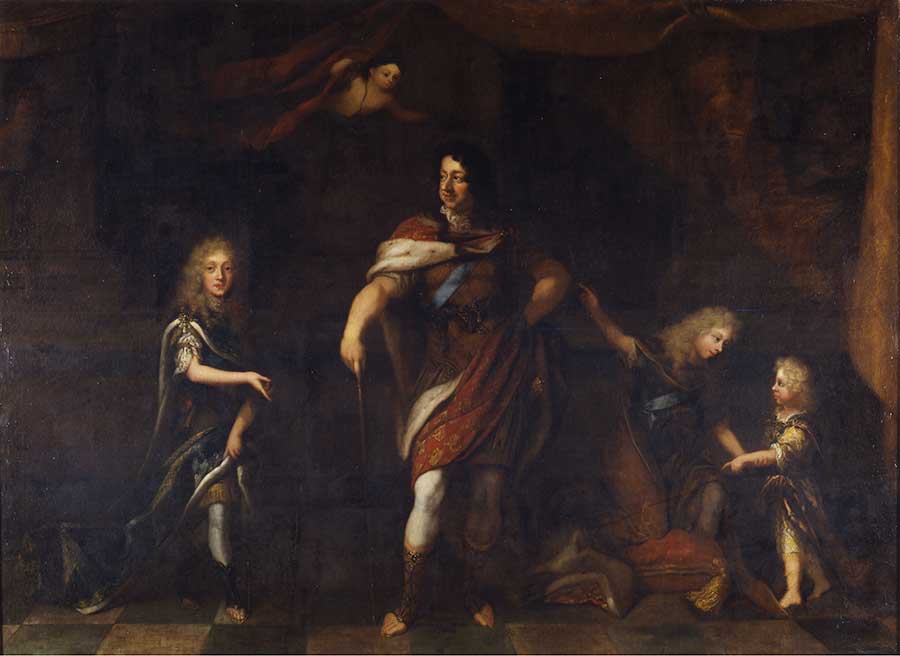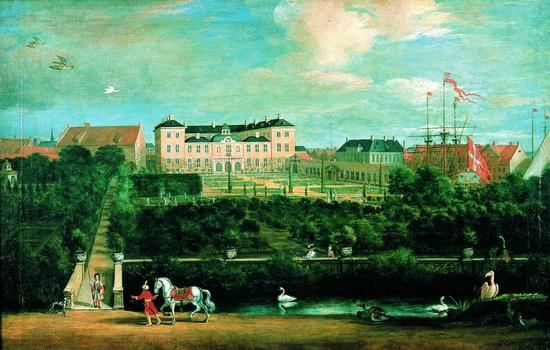by Susan Flantzer © Unofficial Royalty 2020

Queen Charlotte Amalie with one of her children circa 1675; Credit – Wikipedia
Charlotte Amalie of Hesse-Kassel was the wife of Christian V, King of Denmark and Norway. During Christian V’s reign, colonies were established in the Caribbean. The islands of Saint Thomas, Saint John, Saint Croix, and Water Island were originally a Danish colony, the Danish West Indies. The city of Charlotte Amalie, on the island of St. Thomas, was named after Christian V’s wife. Denmark sold the islands to the United States in 1917, and now they are known as the United States Virgin Islands, and Charlotte Amalie is the capital.
Born on April 27, 1650, in Kassel, Landgraviate of Hesse-Kassel, now in the German state of Hesse, Charlotte Amalie was the eldest of the seven children and the eldest of the three daughters of Wilhelm VI, Landgrave of Hesse-Kassel and Hedwig Sophia of Brandenburg.
Charlotte Amalie had six younger siblings:
- Wilhelm VII, Landgrave of Hesse-Kassel (1651–1670), unmarried, died at age 19
- Luise of Hesse-Kassel (born and died 1652), died in infancy
- Karl I, Landgrave of Hesse-Kassel (1654 – 1730), married Maria Amalia of Courland, had seventeen children including Friedrich, who succeeded his father and was also King Frederik I of Sweden, and Marie Louise, who married Johan Willem Friso, Prince of Orange
- Philipp, Landgrave of Hesse-Philippsthal (1655 – 1721), married Katharina Amalia of Solms-Laubach, had eight children
- Georg of Hesse-Kassel (1658 – 1675), died at age 17
- Elisabeth Henriëtte of Hesse-Kassel, Electoral Princess of Brandenburg, Hereditary Princess of Prussia (1661 – 1683), married the future Friedrich I, King in Prussia, had one daughter, died from smallpox at age 21

Charlotte Amalie circa 1667; Credit – Wikipedia
Unlike many other German royals of the time who were Lutheran, Charlotte Amalie’s parents followed Reformed Christianity, which adhered to the teachings of John Calvin. Charlotte Amalie was a strict adherent to Reformed Christianity her whole life. She was well-educated in French, Italian, geography, history, and philosophy, and was interested in physics and pharmacy.

Charlotte Amalie’s husband King Christian V of Denmark, circa 1675; Credit – Wikipedia
On June 25, 1667, at Nykøbing Castle in Falster, Denmark, 17-year-old Charlotte Amalie married 21-year-old Crown Prince Christian of Denmark, the son of Frederik III, King of Denmark and Norway and Sophie Amalie of Brunswick-Lüneburg. Charlotte Amalie is the only post-Reformation Danish queen who was not Lutheran or did not convert to the Lutheran religion. Because of her strict adherence to Reformed Christianity, the marriage contract stated that she was allowed to keep her religion and that she was allowed to hold services in an enclosed room with her own Reformed minister.
The couple had seven children:
- Frederik IV, King of Denmark and Norway (1671 – 1730); married (1) Louise of Mecklenburg-Güstrow, had four sons and one daughter including King Christian VI of Denmark and Norway (2) bigamously Elisabeth Helene von Vieregg, had one son (illegitimate, died in infancy) (3) Anna Sophie von Reventlow, married bigamously in 1712, had three illegitimate children; married legally in 1721, had legitimate three legitimate children, all six children died in infancy
- Christian Vilhelm of Denmark and Norway (1672 – 1673), died in infancy
- Christian of Denmark and Norway (1675 – 1695), unmarried, died from smallpox at age 20
- Sophia Hedwig of Denmark and Norway (1677 – 1735), unmarried
- Christiane Charlotte of Denmark and Norway (1679 – 1689)
- Carl of Denmark and Norway (1680 – 1729), unmarried
- Vilhelm of Denmark and Norway (1687 – 1705), died at age 18

Christian V with his eldest son Frederik and his other sons Christian and Carl; Credit – Wikipedia
Charlotte Amalie’s husband succeeded his father in 1670 as Christian V, King of Denmark and Norway. Christian was anointed at Frederiksborg Palace Chapel on June 7, 1671, but Charlotte Amalie did not participate because it violated her religious beliefs.

Double portrait of Christian V and Charlotte Amalie; Credit – Wikipedia
Charlotte Amalie’s relationship with her husband cannot be described as a love affair but rather a mutual, respected friendship. In 1672, King Christian V began a long-term affair with 16-year-old Sophie Amalie Moth. Sophie Amalie, the daughter of King Frederik III’s doctor, Paul Moth, had grown up at court with her siblings, so she and Christian were well acquainted. Christian had five children with Sophie Amalie, whom he publicly acknowledged. In 1677, Sophie Amalie was recognized as Christian’s official mistress and was created Countess of Samsø. Although Christian V’s public adultery caused an embarrassing situation for Charlotte Amalie, she always made the most of her position as queen, both in her public life as well as in her private interactions with her husband.
During her tenure as Queen, Charlotte Amalie worked for the rights of those who practiced Reform Christianity, especially for displaced Huguenots from France who had settled in Denmark. In 1685, Christian V issued orders for a certain degree of religious freedom for religious refugees. In 1689, the first Reformed Church in Denmark was consecrated in Copenhagen, and Charlotte Amalie was instrumental in its planning and funding. The church had a burial crypt, residences for the ministers, and later, two schools. Although Charlotte Amalie was deeply devoted to her faith, her view on religion was a Protestant ecumenical one, and she corresponded with Protestants of different churches.

Charlottenborg Palace by Jacob Coning, 1694; Credit – Wikipedia
King Christian V died in 1699 and was succeeded by his son, King Frederik IV. Charlotte Amalie allowed her daughter-in-law, Louise of Mecklenburg-Güstrow, to take her rightful place as Queen. Charlotte Amalie kept a separate court and during the winter lived at Charlottenborg Palace, which is named after her, and then during the summer, she lived at Nykøbing Castle. She owned several estates and became quite wealthy from their income. In 1703, when her son Frederik IV made a bigamous marriage by marrying his mistress Elisabeth Helene von Vieregg while his wife was still living, Charlotte Amalie was deeply grieved by his behavior but never expressed her great displeasure to her son.
On March 27, 1714, Charlotte Amalie, Queen of Denmark and Norway, aged 63, died of scarlet fever after being ill for six days at Charlottenborg Palace in Copenhagen, Denmark. She was buried in a baroque marble tomb designed by Christoph Sturmberg next to King Christian V’s tomb in the nave of Roskilde Cathedral, the traditional burial place of the Danish royal family, in Roskilde, Denmark.

Tomb of Charlotte Amalie in Roskilde Cathedral; Photo Credit – Susan Flantzer
This article is the intellectual property of Unofficial Royalty and is NOT TO BE COPIED, EDITED, OR POSTED IN ANY FORM ON ANOTHER WEBSITE under any circumstances. It is permissible to use a link that directs to Unofficial Royalty.
Kingdom of Denmark Resources at Unofficial Royalty
- Kingdom of Denmark Index
- Danish Orders and Honours
- Danish Royal Burial Sites: House of Oldenburg, 1448 – 1863
- Danish Royal Burial Sites: House of Schleswig-Holstein-Sonderburg-Glücksburg, 1863 – present
- Danish Royal Christenings
- Danish Royal Dates
- Danish Royal Residences
- Danish Royal Weddings
- Line of Succession to the Danish Throne
- Profiles of the Danish Royal Family
Works Cited
- Da.wikipedia.org. 2020. Charlotte Amalie Af Hessen-Kassel. [online] Available at: <https://da.wikipedia.org/wiki/Charlotte_Amalie_af_Hessen-Kassel> [Accessed 29 April 2020].
- De.wikipedia.org. 2020. Charlotte Amalie Von Hessen-Kassel. [online] Available at: <https://de.wikipedia.org/wiki/Charlotte_Amalie_von_Hessen-Kassel> [Accessed 29 April 2020].
- En.wikipedia.org. 2020. Charlotte Amalie Of Hesse-Kassel. [online] Available at: <https://en.wikipedia.org/wiki/Charlotte_Amalie_of_Hesse-Kassel> [Accessed 29 April 2020].
